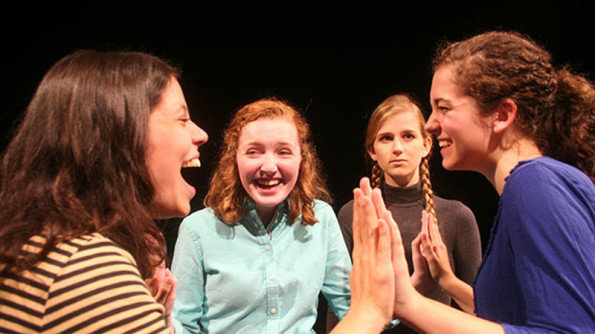
Imagine U’s latest show “The Hundred Dresses,” directed by Rives Collins, is a story about bullying, peer pressure and acceptance. In the musical adaptation (based on the book “The Hundred Dresses” by Eleanor Estes), Wanda Petronski, a young girl from Poland, is teased and excluded at her new school because of her strange accent, her clothes and her inexplicable claim that, although she wears the same dress every day, she has a hundred dresses at home. The story is told from the perspective of Maddie (played by Communication junior Eliza Palasz), a classmate of Wanda’s, and illustrates Maddie’s struggle with wanting to fit in versus doing what’s right.
The cast of the “The Hundred Dresses” was fantastic. Everyone was engaged and committed, and the production felt professional enough to keep it from being trapped in “kid show” territory. In a cast of eight, four actors were freshmen — a great way to show off some new talent.
Although I loved the actors, I can’t say I loved the show itself. The music is really great and unexpected for a children’s show, with a contemporary, slightly jazzy sound, but it sets a standard the lyrics don’t meet. There are a few standouts, though, that will stick with you and make you forgive the duds (I’ve been humming “Wanda is Missing” for the past three days), and the voices in the cast do a lot to redeem the weaker numbers as well.
The story feels slightly rushed, especially considering the complexity of the topic, and, in the attempt to develop characters in such a short amount of time, it ends without resolving all of the plot lines. But the primary goal of “The Hundred Dresses” is to educate about bullying, and that comes across clearly. Probably the best aspect of the show is the way it illustrates the differences between how girls and boys tend to bully. Too often bullying is seen as only being physical, such as when two male characters in the show complain about being physically harassed by an older student. In response, one of the girls, Peggy (played by Communication freshman Maggie Monahan), remarks that boys are so mean to each other; however, she is the same girl who takes the lead in making fun of Wanda.
“The Hundred Dresses” is absolutely gorgeous. The set is simple, mainly composed of different block configurations, but distinctive lighting keeps it interesting and does an especially good job of conveying the emotions in each song. The staging decisions yielded some incredibly beautiful moments: My personal favorite was a song on changing seasons that the actors signed along with. That aspect alone would make me consider seeing it a second time, and Rives Collins and all of the designers associated with the show have a lot to be proud of.
So would I recommend it? Yes. It’s a great cast working with an iffy script, and they pull it off very well. The story is serious without being overly preachy, with some funny moments and little subplots to lighten the mood. See it for a good time, but don’t expect it to be groundbreaking — and prepare yourself for swarms of elementary schoolers.
Email: [email protected]
Twitter: @becca_eh

